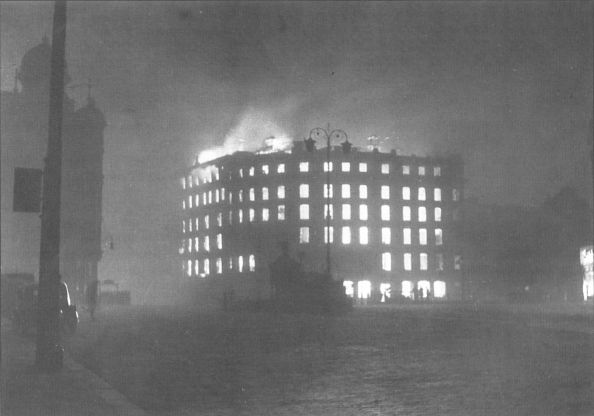|
with the
situation that developed rapidly around them that night. Many had
disappeared, exhausted, into shelters, or with one fire seemingly under
control, were too tired to know where to turn next. In his book, The
City That Wouldn't Die, Basil Collier describes how 'firemen swayed on
their feet, still going through the motions of firefighting'. Elsewhere an
officer discovered two firemen 'as drugged as men in shock', still
clinging to a branch, and he had to punch them into wakefulness. By London
Bridge 'two firemen lay asleep in the gutter', while a third sat upright
beside them singing Rule Britannia.
The incident at the Surrey Music Hall was one of a number in which firemen
lost their lives in London in World War II. It is better remembered
than most because it is recorded in more detail. Despite its particular
ferocity it nevertheless describes a situation that must have been
repeated, to a greater or lesser extent, all over London on many other
nights.
In the past month I have visited almost thirty other sites where multiple
deaths occurred, from Maida Vale to Poplar, and from Herne Hill to
Woolwich. Sometimes two or three occurred on the same night. A pattern
eventually merges which enables one to build up a clearer view of
firemen's experiences under attack. Only then is it possible to see beyond
the familiar images of silouhettes against the flames, to recreate real
people, real places and real events. And yet, and yet...... perhaps in the
final analysis, the final words will still be those of one who was there,
writer and fireman, William Sansom. The experience is too violent
for the arts to transcribe; there will never be an adequate reportage to
convey to posterity a living idea of the truth of such experience.
Posterity may indeed speculate on the Battle's trailed miseries, on the
histories of courage and endurance, on the vigil before the battle and the
tired aftermath, even on the appearance of the battle itself with its
reported volumes of shell and blood and tactic - but of the real
sensations of the thick of the battle it will know nothing. It cannot. the
pace has become too violent, machines move too fast for the nerves'
perception, the din outsounds the ear, movements and winds and lights
strike with such great impact that this can scarcely be perceived and even
then never, neither in the symbols of language nor in the tones of paint,
be
recorded.
© Stephanie Maltman 2000 |
|
